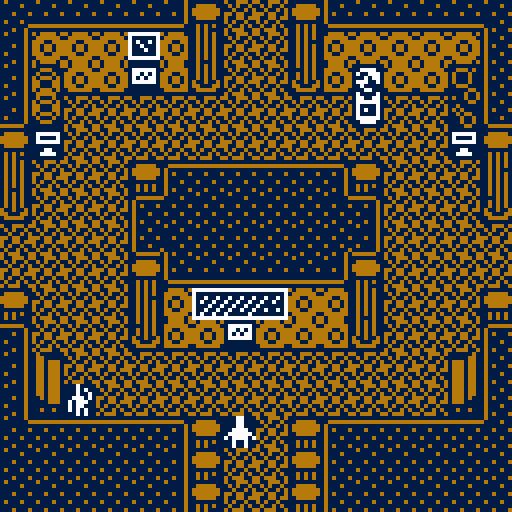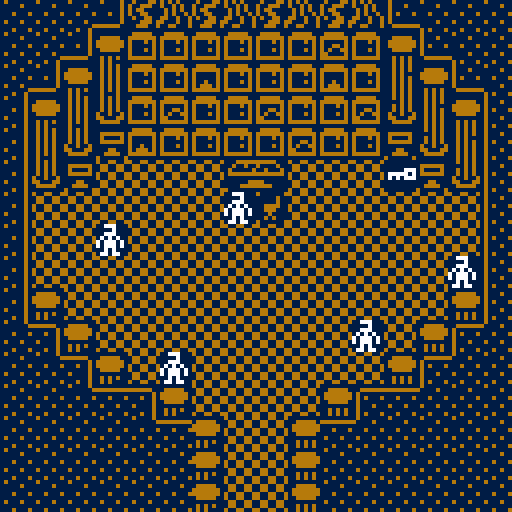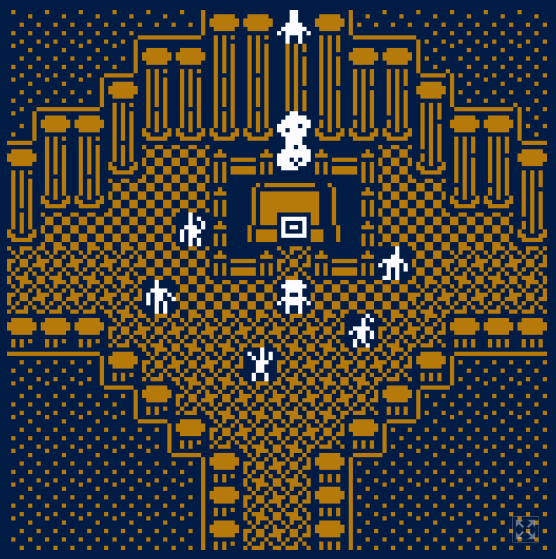Museum of everything
Welcome to the Museum of Everything.
This museum is a work of fiction and thus doesn't abide by the laws of space-time.
The inner workings of its architecture are in their essence random and chaotic.
All art objects in the Museum are procedurally generated and may feature some unpleasant or messy images.
Be aware of this as you move forward.
Game created for BITSY FEST (bitsy jam #77). Special thanks to Museum of Screens, ledoux and Dahuanna.
P.S.: Any similarities with the actual Museum of Everything are coincidental
| Status | Released |
| Platforms | HTML5 |
| Rating | Rated 5.0 out of 5 stars (9 total ratings) |
| Author | Valeriy Petrov |
| Genre | Adventure |
| Made with | bitsy |
| Tags | 8-Bit, artgame, Bitsy, bitsyfest, Pixel Art, Procedural Generation, Walking simulator |
Download
Download NowName your own price
Click download now to get access to the following files:
museum_of_everything 1.2 download.html 617 kB



Comments
Log in with itch.io to leave a comment.
Very nice game Valeriy! ...Unfortunately i got stuck around here for no reason (up here)

Anyway keep up the good work! Those security guards are very relevent
Hello!
Thank you for your kind words and for spotting the bug! It should be fixed now
Beautiful art work, again! I'm always jealous playing your games as everything fits together so neatly.
I read through the posts with Mandy and agree with you in regards to randomisation vs the plots in the game. I was very intrigued by the refugees quest, and particularly the concept of people suffering right next to art inspired by that suffering (and critics still being more interested in the art), and to be honest I was a little disappointed there wasn't a 'bigger' thematic resolution to it.
HOWEVER, the randomisation aspect did feel the main aspect of this game and it's superb. The fact that this game works so smoothly with how much is in it incredibly impressive. You definitely nailed that feeling of walking around an endless, confusing art space. All while still in vanilla Bitsy!? Great work.
Thank you for your kind words, this means a lot!
Interesting thoughts on the subject of the refugees' quest. It was actually partially inspired by my real-life experience at the beginning of the war in Ukraine (we were hiding in an underground art gallery for several days while the city was bombed). Luckily, there were no evil critics and security guards to shy us away :)
I feel like I understand what you saying regarding the resolution of the quest. Truly, the scope of my project at some point has become its curse (it never happened before, and now it happened again, haha). Creating the museum and art objects took a lot of time and effort, and when it was time to make the quests, I was already a bit jaded. Also quest creation process itself was a bit junky, due to how much code the game already had (it is worth noting, that very long scripts may make Bitsy lag and even crash from time to time). Dealing with all those technical problems made me somewhat lose the bigger picture, and this is probably why the refugees' quest resolution may feel less thematically resonant than the one of the living statue.
In any case, thank you very much for playing the game and providing your feedback!
I was interested in how it all worked, so I copied the code from the HTML into Bitsy and saw the sheer size of some of those dialogue options. It was lagging for me as well just opening it, so have no idea how you managed to keep it all together and working smoothly :)
In hindsight, I think I was focused on the refugee quest due to them sadly coming in the news so often recently. I have a Ukrainian friend here in the UK who brought her family over last year, and I've been watching the news about Palestine recently also. It's been on my mind a lot, and the idea of those kind of people just trying to survive in a peace-time space for art, with art pieces depicting people just like them, was a powerful one to me.
Ultimately though, it was a game jam with limited time and think you should be really proud of the randomisation aspects. I think the quests are more of an 'icing on the top' really. I had been wondering if the game was related to how you experienced the war, as I had played your other games set in Ukraine around then. Thank you for sharing that.
Oh wow, I never thought somebody would look into my shitty code. I appreciate you going the extra mile to look into it. To make it work I actually copied and pasted it into the notepad, then edited it, then copied and pasted it back in the hope that it would work fine. It was a hell of a job and quite a stressful one too.
That 'icing on the top' metaphor is spot on. Looking back, I really feel like these quests were more of an afterthought, which, considering their heavy subjects, probably have not reflected well on their quality. But I'm glad that some people played them and find them interesting still.
This is such an incredible achievement. You created a randomized space that nevertheless feels cohesive and real. I loved stepping into the museum and feeling unmoored from the laws of space. Plus, you put two compelling storylines into a game built on procedural content! I loved having to navigate by art types, since traditional navigation just wouldn't work in a space like this. Also the short mini-puzzle with the guards and the key was just so cool. I played the whole thing whispering "how'd you do that??" to myself because it all just works so well! Really, really amazing work!
Thanks, your praise means a lot to me! This was exactly the experience that I wanted to achieve, and I'm so glad you had it.
It did take a lot of work to make, and I think I can safely say, that some of the stuff I wanted to do was kinda testing the limitations of Bitsy as a game engine. For example, art objects scripts were so large, that my browser was lagging and Bitsy occasionally just crashed and reloaded the webpage. To be honest, I wouldn't recommend anybody to make a project of this scale in Bitsy, although I am in no way blaming the engine itself, only my own inability to optimize my code and limit the scope of my projects :)
The art is so good. <3
Thank you! <3
Very clever use of procedural generation, though eventually it becomes clear that the art is variations on the theme
I'm glad you've liked my approach to pc. Thanks for noting the limitations of the art pieces pool. I was trying to make it quite large, but then again, my goal was never to try to make it seemingly endless. I guess part of the fun for me was seeing the same pieces in different contexts and combinations.
I played Museum Of Everything yesterday but hadn't commented because I think I hit a bug and so I thought maybe I should poke around in the code before doing so but I haven't had time. (I'm quite intrigued to see how you built this. I found the randomness frustrating yet also not because I could see that the game is built to guide the player to various points and not leave you floating around, lost forever.)
Anyway, the bug(?): I unlocked the room for the refugees and then in trying to find my way "down" I ended up here at the top of this screen and I couldn't move in any direction so I had to give up.
That's a bug alright, thanks for noticing!
Glad you've found my game interesting and worth checking out. What would you say frustrated you the most in the randomness?
It increasingly felt like my sense of agency was being taken away. There were things in the game I thought I needed to do, or wanted to explore if they were something I was supposed to do, and instead I felt as if I was being pulled along with no way of knowing when I would be able to do what I wanted to do - or if I would be able to at all. Bitsy's lack of a game saving feature complicates this because the player could be in one of two states of mind when playing: either wanting to push the narrative along because they are becoming bored or they need to finish because they need to make dinner in the real world or whatever, or they have lots of time and are curious and happy to linger by wandering around looking at art before eventually tackling some game stuff.
Also, for someone such as myself who very much relies on my sense of direction and spacial awareness, it was frustrating having that taken away from me but I know that was part of the game. I have a messy checklist in my head - I have to look for x, I need to do y, etc - that builds as I play a game based on what I suspect are potential text/dialogue cues but it starts to forget things (cognitive overload) and having no way to backtrack to retrigger those thoughts (for me, visuals help with memory) to remind me contributed to my feeling of a lack of agency.
However I've played this again. The first time I played I was in the rushing state of mind, whereas now I knew it would take some time so I waited until I had the time. Second time around, because I had an idea of the game already, I looked more closely for game elements and what might have previously confused me, and came to the conclusion that there are a bunch of different stories/puzzles to solve (refugees, art critics, statue, war something(?), ...?) and you're only going to get a chance to solve one while possibly having little insights into the fact that the others exist. - is this correct? (This time I had the refugee key but then the room never reappeared and I ended up helping the statue.) This is unusual because in most games you solve all the puzzles - or you are forced to make mistakes where you see that you then cannot solve some of the puzzles so you move on - and then it ends. Here you solve one thing and you have this vagueness about other things but you can't "reach" them and then the game gently escorts you out ("down").
I hope this makes sense? It's very hard to explain and I've also gone on a bit of a tangent.
Also, I found another bug that generates text such as "The sculpture made of garbagenullnull It represents [...]", "The sculpture made of concise jet-blackinknullnull It [...]", and "The sculpture made of evocative watercolorsnullnull It [...]" etc.
Wow, thank you for detailed feedback.
The game works as follows: there are a lot of "regular" rooms with art objects, and there are a few of "special" rooms with key characters that give you quests. Each time you go through an exit from a room, a random room is selected from a pool of "regular" rooms. But each third room is selected from a pool of "special" rooms, which changes based on what quests have you taken and what stage is currently active.
So, for example, you can stumble upon a room with a critic in search of a statue, or you can stumble upon a statue itself. Once you've led the critic to the statue and taken both his and the statue's quests, their room is taken from the pool of "special" rooms until you finish any of their quests (find four critics or find four materials respectively). Then, you have the choice to complete either the critic's or the statue's quest (you can't complete both, since they contradict each other). After that, the pool of "special" rooms will only contain a room that corresponds to the ending you've chosen.
Overall there are 2 storylines, each with two possible endings: the statue's story (either help the statue escape, or help critics completely immobilize her), and the refugee's story (either get the key and let refugees into the vault, or notify guards and get refugees expelled from the museum). To find the guards you have to "follow the images of war", i.e. looking for art pieces that have war-related images in them.
Hopefully, that makes sense to you ) The main problem, as you have rightly pointed out, is randomness and the fact that player has no agency over where and when they will go. This was kinda the main initial idea behind the game (to make an impossible, confusing space that player can wander through indefinitely), but also, as you've made me realize, ended up being its main foil (taking away player's agency over a story flow).
Thanks again for paying so much attention to my game! It's a dream of every creator to have such a devoted and honest critic as you :)
P.S.: thanks for noticing another bug. I'll look into it when I have time to do another patch.
You're welcome. I'm glad I could offer useful feedback. I've been reviewing video games professionally for over 20 years and in the years leading up to the pandemic I spent a lot of time with the Cape Town game dev community learning a lot from their perspective (the Cape Town - and , in fact, South African - game dev community is really great). Plus, of course, I've now started using my knowledge to experiment with making my own small games.
Your explanation makes perfect sense and now that I know how it works (without having to look at the code to figure it out!) I can go back in and control which stories and endings I see, which is totally the opposite of what you intended but it will satisfy my curiosity about the narrative bits I haven't experienced.
I learnt something about agency that I hadn't thought about before so this was a good learning experience for me too.
I'm glad you've found time to replay the game and find all the narrative pieces. This project is a lesson for me to be more careful with randomness if I want to tell a story.
P.S.: Greetings from the Ukrainian game dev community to the South African game dev community!
I love the art of the game. The museum floating in the void looks so cool! I really love the floor tiles too! The descriptions of some of the artwork are unsettling, reminding me of Lovecraftian horror.
I'm glad that you've liked my game. The Lovecraftian vibe was unintentional, but I can kinda see where it's coming from. It's interesting that the game made you feel this way, thank you very much for sharing your thoughts!
I love the sprite work here, it's absolutely phenomenal. The Museum is a messy, unsettling, compelling delight.
Thanks! I'm glad you've liked my art :)